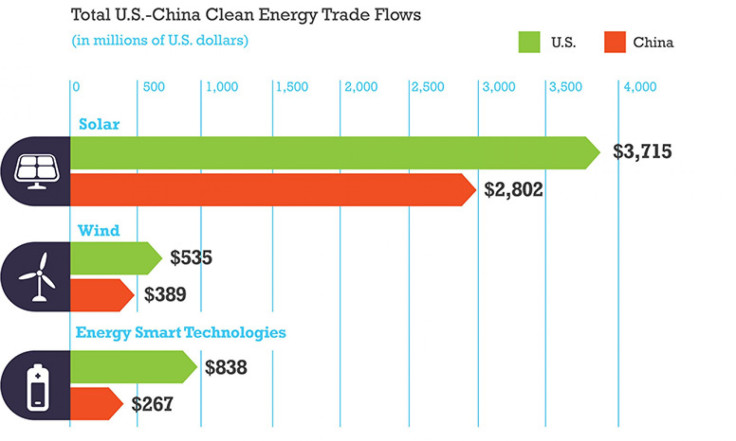US-China Trade: China Loves America’s Green Technology

As unlikely as it may sound, the U.S. actually has a trade surplus with China -- in the clean energy sector. The United States' strength in the advanced manufacturing of components and capital equipment to produce finished clean energy technologies has led to a $1.63 billion surplus in the clean energy trade over China, according to a new report.
More than half a trillion dollars’ worth of goods and services passed between the world’s two leading economies in 2011, the most recent year for which complete data is available, according to a study released by the Pew Charitable Trusts. The study is based on data gathered and analyzed by market research firm Bloomberg New Energy Finance.
The two countries are the largest and second-largest global electricity markets and greenhouse gas emitters and the leading recipients of clean energy investment. Nearly two of every five dollars invested in clean energy worldwide since 2004 has gone to one country or the other.
All told, the U.S. and China traded more than $8.5 billion worth of clean energy goods. U.S. firms enjoyed surpluses in all three major clean energy sectors: solar, wind and energy smart technologies, or products that use energy efficiently.
Solar energy product exports are the largest component of U.S.-China clean energy trade for both countries. Combined, firms based in the two nations traded more than $6.5 billion worth of products and services in 2011.
China used its manufacturing and labor edge to produce large numbers of cells and turbines. But the U.S. focused successfully on high-margin goods and services that ultimately raked in greater profits. On a net basis, the U.S. enjoyed a $913 million surplus in the solar sector in 2011.
In addition, many jobs associated with China’s high-volume manufacturing operations are low-skill, low-wage jobs. Over time, China’s advantage in low-cost labor is eroding because of the steady wage growth of its workers.

As with solar, the U.S. wind industry -- the smallest component of the three main sectors of clean energy trade between the two countries -- excels in relatively high-margin specialty materials produced by large firms and in sensitive electronic and other control systems, with U.S. trade to China totaling $534.9 million.
China’s largest trade contributors are wind turbine towers -- a trade driven almost entirely by logistical concerns rather than pure cost advantages -- and turbine rotors manufactured under a U.S.-China joint venture. China’s wind energy exports to the U.S. totaled $388.7 million. Overall, U.S. firms had a net trade surplus of over $146 million.
In the energy smart-technology sector, which includes smart meters, light emitting diodes, advanced lithium-ion batteries and electric vehicles, the U.S. enjoyed a net trade surplus of $571 million in 2011.
The report cautioned, however, that to stay ahead, U.S. policymakers must continue to invest in the success of its clean energy companies -- in promoting research, in growing domestic demand and also boosting global sales.
Consider the U.S. wind industry, where demand could decline by 50 percent or more this year. “The inability of Congress to extend the production tax credit used by the wind industry until the end of 2012 caused new orders to slump last year and will result in a substantial imbalance between supply and demand until at least 2014,” the report said.
“The U.S.-China clean energy trade’s ties are every bit as nuanced and complex as those in other industries,” said Michael Liebreich, chief executive of Bloomberg New Energy Finance, in the report. “They stand to become even more so in coming months as the two nations quarrel over issues of intellectual property rights, dumping of goods onto international markets, and tariffs.”
© Copyright IBTimes 2024. All rights reserved.






















